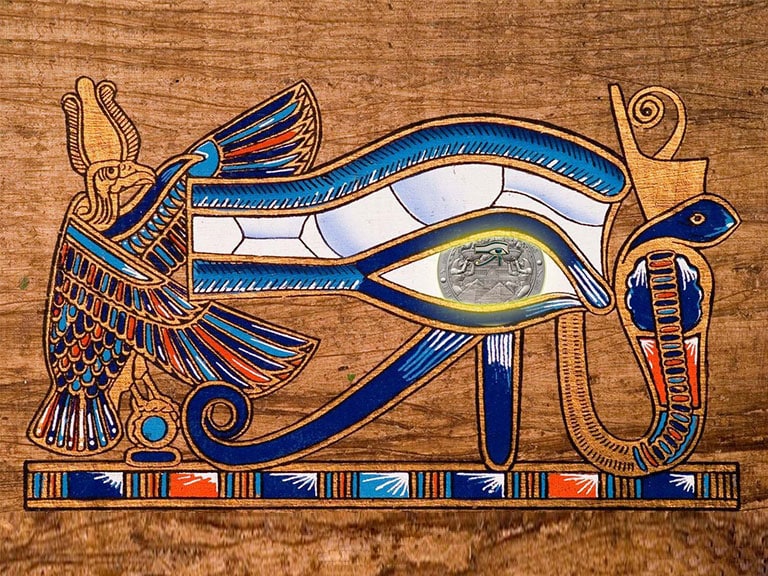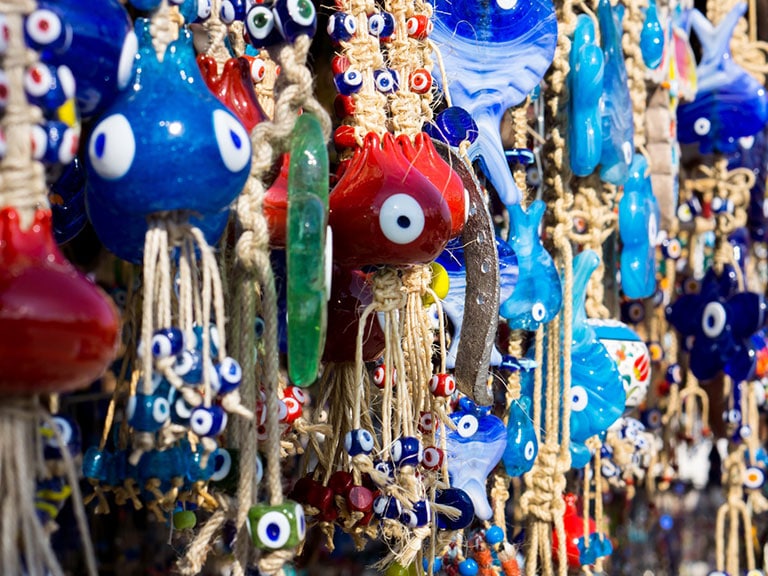Upon landing in Istanbul, or even before arrival, one of the first things to catch your eyes is an evil eye bead. It is a cultural thing that has over 5000 years of history and is still used all around the country, especially for a newborn baby, a brand new car, or even a newly built house to keep that bad energy away.
Actually, not only in Turkey, the Turkish evil eye can be seen on bracelets, necklaces, and other forms of jewelry almost across the entire globe, especially among Jewish, Muslim, and Christian cultures. So, the jewelry shops aren’t the only places where you’ll see this symbol as a good number of Turkish people have it hanging up in their houses, shops, offices, and cars as a part of their life.
For example, if you head to Cappadocia, it is more of a touristy thing, but you’ll find these symbols even hanging from trees. This phenomenon is more than an exciting accessory, however. It has a fascinating history, meaning, and superstition behind it—a history that we’re about to share with you.
Keep reading to find out more about this beautiful phenomenon as you might want to get as a pendant necklace or a bracelet. Before doing so, learn how it still impacts people and cultures to this very day.
1. The Amulet
Before we get into the history and meaning of this culture, let’s talk about how to tell it apart from the amulet itself. The evil eye is a spiteful glare essentially. It can be cast on anyone by a jealous person who believes that the other person does not deserve the life/item (whatever they are jealous of) they have. The consequence is that the person is vulnerable to get hurt, illness, or even end with death. The same can happen to objects as well that when we break a piece of glass by accident, we say, “the evil eye is gone away.”
As our ancient ancestors did, some still believe in people with supernatural power that can cause this energy. The heritage dates back to ancient history again, where Egyptians considered blue color as the divine while it was a symbol of gods for Sumerians.

2. The Origins
The history of the evil eye dates back to ancient Mesopotamia, followed by Assyrians and Phoenicians, Celts, the Hellenistic Era, Roman, Jewish through to the Bible, Europe, and the modern-day world.
One of the earliest mentions of the evil eye is seen on a cuneiform of Sumerians advising water remedies against the evil eye. The ancient cuneiform found in Mesopotamia says, ‘The eye ad-gir, the eye a man has…? The eye afflicting man with evil, the ad-gir. Unto heaven is approached, and the storms sent to rain.’ And another Sumerian cure says, ‘Seven vases of meal-water behind grinding stones. With oil mix. Upon (his) face apply.’
The concept continued with the Greeks and Romans in similar superstitions. They believed the curse was the Gods and Goddesses’ way of bringing bad luck and misfortune to those who show a good deal of hubris.
From there, it extended out to those who didn’t merely have a swollen head. Anyone who received any praise was vulnerable to the envious stare.
Today, not only Turks but since it also has a beautiful looking, it became one of the best souvenirs in Turkey that the beads are all around the world now.
3. Across Different Cultures
The evil eye means pretty much the same thing across several different cultures. The main idea is all about the curse of someone more fortunate and successful in life. However, there are some exciting takes that we discussed below.
Hinduism
Hindus believed that even an admiring glare could cause the evil eye curse to fall upon someone. When this happens, their cow’s supply of milk will dry up, and they would be without. This caused a tradition where you give a bowl of milk to someone you admire to counteract the evil eye.
Also, in Hindu culture, you’re most vulnerable to the evil eye when you’re getting married, going through puberty, or expecting a child.
South America
In Brazil, the superstition is called the “fat eye” rather than the evil eye. They believe it goes after those who have received insincere compliments. If you’re given a sincere compliment, then you’re fine.
Europe
In Europe, the evil eye originated with the thought that a harsh glance can give someone bad luck. The evil eye is also associated with witches. So, those who have a unique eye color (Germany) or a unibrow (Ireland) are thought to have a stronger ability to cast it.
Some Other Countries
Macedonia, Albania, Bosnia, Herzegovina, Bulgaria, Greece, Cyprus, Syria, Lebanon, Israel, Egypt, Armenia, Iran, India, Afghanistan, Pakistan, Iraq, and Azerbaijan also have the belief pretty much alive.

4. The Hamsa
As the written symbols used by Jews, Muslims, and Christians to ward off the evil eye, the Hamsa has a similar meaning and brings luck, happiness, and good health whoever owns one. While it is hard to track the origins of its history, one can quickly get the feeling of an amulet at a glance.
5. The History of the Turkish Evil Eye
To thwart the evil eye, the Turkish people created the Nazar Boncuk charm, also known as the Turkish evil eye. The point of the amulet is to repel evil spirits and keep you safe from harm. So, it is not to have good luck; it is all about protection.
People began to hang the amulet almost on everything from their pets to their children. It’s also a common practice to wear them on your person and put them around the house.
Over time, the charm will wear and crack. This isn’t a bad omen. It means that the beads have done the job, and you’re safe. As soon as the bead breaks, you’ll need to get another one to replace it and keep the protection to be sure that the evil spirits don’t come back.

6. Why Blue Color and What Materials Are Used?
Even though it’s in the name, the amulet is a trinket that’s used to get rid of that evil eye. It is made out of beautiful blue glass, in one specific oven and certain colors majorly consisting of the standard order of blue, white, yellow, and black.
It’s comprised of two primary colors, blue and light blue. Blue is the color of protection, while either yellow or light blue is in the middle, the protector, mostly black, is centered on the blue background.
The power of blue radiates positive energy and symbolizes good karma. Light blue is a color that’s most commonly associated with the sky. This color in the evil eye amulet is a symbol of truth. Blue symbolized god in the sky in ancient history; it has the power of relaxing the tension once looked at.
7. Protecting Yourself Against the Evil Eye
There are more ways to protect yourself against the evil eye than wearing charms. Ancient Greeks fired up the incense and carried crosses. Brand new mothers would put protection items under their pillows such as gunpowder, a nail, and garlic.
In some areas, people burned bear fur to get rid of the evil eye. Christians in European countries would create a cross with their hands while pointing their pinky and index finger toward the curse’s origin. These are only a few supposed healing and prevention methods.

Where to Get an Original Piece in Turkey?
Some call the village of Nazarkoy in Izmir “the evil eye village” as it reminds you of the smurfs village with the blue and consisting of these small ovens to make evil eyes. It gets this name from the number of glass amulets you’ll find there. If you visit Cappadocia, you’ll see where people have hung hundreds of charms upon the trees. While most of those are not original pieces, you can get one as a souvenir, but make sure it is glass and layered with the primary colors instead of a flat surface.
About any souvenir shop in Turkey has some variant of the Turkish evil eye for sale, be it on a bracelet or a key chain. The evil eye isn’t only an attractive piece of jewelry but available in many different forms.
There’s nothing like picking up a charm straight from the source. When in doubt, please check with your tour guide where you can get the best one and if you are arriving soon, contact us to ask about our Turkish tours today.
